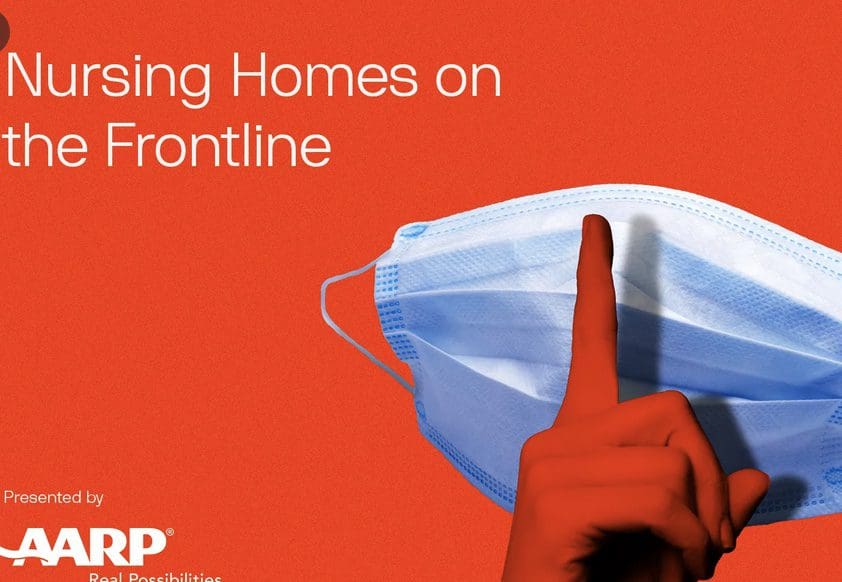Search Posts
Recent Posts
- Rhode Island Weekend Weather for April 20/21, 2024 – John Donnelly April 20, 2024
- Westerly to complete more resilient and people-friendly Main St. streetscape with $300K award April 20, 2024
- In the News… quick look for week ending April 20th April 20, 2024
- WaterFire scheduled announced for 2024 April 20, 2024
- Burn with Kearns: Ignite Your Transformation: Join the 90-Day Fitness Challenge! – Kevin Kearns April 20, 2024
Categories
Subscribe!
Thanks for subscribing! Please check your email for further instructions.

AARP’s new COVID-19 Dashboard for national/local Nursing Home Data
AARP Gives a Dashboard Snapshot of COVID-19’s Impact on Nursing Homes
By Herb Weiss, contributing writer on aging
While public health experts are predicting a second spike of the COVID-19 virus, expecting it to hit the nation as early as – now – and reaching its peak in December, AARP releases its Nursing Home COVID-19 Dashboard created to provide four-week snapshots detailing the infiltration of the virus into the nation’s nursing homes and its impact on residents and staff. AARP’s latest Public Policy Institute analysis is the result of the Washington, DC-based aging advocacy group’s successful efforts to push for the public reporting of nursing home COVID-19 cases and deaths.
Using data collected by the Centers for Medicare & Medicaid Services—which is self-reported by nursing homes—the AARP Public Policy Institute, in collaboration with the Scripps Gerontology Center at Miami University in Ohio, created the AARP Nursing Home COVID-19 Dashboard to provide four-week snapshots of the virus’ infiltration into nursing homes and impact on nursing home residents and staff. The first release of the dashboard on October 14 reveals that nursing homes in every state reported shortages of PPE, ranging from 8 percent of facilities in the best-performing states, to 60 percent in the lowest-performing state. The dashboard also compared state and national data on COVID-19 cases and deaths, staff cases and staffing shortages.
Key Findings of AARP’s First Dashboard
The AARP Public Policy Institute will analyze data and report on key findings as the dashboard is updated over time. Here are some observations about AARP’s first Dashboard (using data from August 24 to September 20, in which 95 percent of the nation’s 15,366 nursing homes submitted data for this time period):
According to the database, in every state, nursing homes indicated a shortage of PPE (defined as not having a one-week supply of N95 masks, surgical masks, gowns, gloves and eye protection during the previous four weeks). Nationally, about one quarter (25.5 percent) of nursing homes had a PPE shortage during the Aug. 24 to Sept. 20 reporting period. In the highest performing state, 8 percent of nursing homes had a PPE shortage; in the lowest-performing state, 60 percent did not have a one-week supply.
The researchers note that while considerable attention has been paid to infections among nursing home residents, it is also critically important to consider direct-care staff. In the four weeks ending Sept. 20, one-quarter (24 percent) of nursing homes had at least one confirmed COVID-19 case among residents, and twice as many (50 percent) had at least one confirmed staff case. Per 100 nursing home residents, there were 2.6 COVID-19 resident cases and 2.5 staff cases, corresponding to a total of about 55,000 cases nationally.
Finally, there is considerable variation across states. COVID-19 deaths in the four weeks ending Sept. 20 averaged 0.5 per 100 residents across the nation (about 1 out of every 200 residents). At the state level, the death rate was as high as 1.2 per 100 residents (about 1 out of 80), and several states reported no resident deaths in the past month.
Looking at Rhode Island, AARP’s first dashboard detailed the following:
· 2.2 COVID cases per 100 residents
· 0.2 COVID deaths per 100 residents
· 1.7 staff cases per 100 residents
· 19.7 percent of nursing homes without a 1-week supply of PPE
· 28.9 percent of nursing homes with staffing shortages
AARP’s dashboard will be updated every four weeks to track trends over time and will evolve to include more categories to follow other measures of interest.
As Others See It – in Rhode Island
“We have been very clear in our messaging: No state has done a good enough job to protect nursing home residents and staff,” said AARP Rhode Island State Director Kathleen Connell. “That said, it is good to see that in the first round of data postings on the AARP Nursing Home COVID Dashboard shows Rhode Island in better-than average shape compared to other states. But to our point, anyone in Rhode Island with a loved one in a nursing home expects – hopes and prays – for more than ‘better than average.”
“As we see daily reports of increased cases and deaths, safety concerns for nursing home residents and staff should be increasing as well. The pandemic is far from over and among many complicated aspects of dealing with it is transparency. The COVD Dashboard provides the public with a benchmark and tracks monthly changes; people need to pay attention and demand action at all levels to make nursing homes safer. These aren’t just numbers. These are lives,” says Connell.
On the other hand, the Rhode Island Department of Health questions the accuracy of AARP Nursing Home COVID-19 Dashboard as it relates to its Rhode Island findings. “The data don’t accurately reflect the Rhode Island reality in part because of how the questions are phrased,” says Joseph Wendelken, RIDOH’s Public Information Officer, specifically related to PPE data. “The question asks about PPE in the nursing homes. Nursing homes receive a weekly supply of PPE from their corporate warehouses. The question asks about one point in time. On occasion, reporting happens shortly before facilities receive their re-supply,” he says.
“RIDOH has taken several steps to protect nursing home residents, says Wendelken, noting that his department has built Congregate Setting Support Teams to conduct targeted to facilities regarding infection control, PPE, testing, and staffing.
“We have weekly contact with facilities. We’ve worked with facilities to develop creative plans for reopening. We have implemented regular testing of staff every 10 to 14 days. We will take the lessons and experience we’ve gained from these past seven months and apply them to the increase in cases we see today,” adds Wendelken.
According to Scott Fraser, President/CEO, of the Rhode Island Health Care Association (RIHCA), the AARP analysis shows what his organization has been saying in the last few weeks and months—that COVID-19 cases in nursing homes continue to drop. “Rhode Island is below the national average in all categories measured for this dashboard,” he says, stressing that the number of cases in nursing homes is dropping as is the number of deaths,” notes Fraser.
The successful efforts to protect nursing home residents and staff can be directly linked to the measures the facilities have taken since the pandemic first hit, notes Fraser. “We are stocking up on PPE. We initially suspended visitation. We are testing staff regularly and residents when necessary. We are carefully monitoring visitors and vendors who come into our homes. We isolate and quarantine anyone who tests positive or any new resident who moves into our facilities,” he says.
Fraser says that RIHCA continues to advocate for regular testing of vendors who come into the state’s nursing homes, including ambulance drivers, lab technicians, and hospice workers. RIHCA continues to call on RIDOH to renew the policy of having two negative tests before a hospital patient can be released to a nursing home and to allow those certified nursing assistants who received temporary emergency certifications to obtain their permanent licenses.
A Call to Action
More than 84,000 residents and staff of nursing homes and other long-term care facilities have died from COVID-19, representing 40 percent of all coronavirus fatalities in the U.S., according to Kaiser Family Foundation’s most recent analysis released on Oct. 8. Yet in its statement announcing the release of its Dashboard, AARP charges that federal policymakers have been slow to respond to this crisis, and no state has done a good enough job to stem the loss of life.
According to AARP, policymakers have taken some action, such as requiring nursing homes to self-report COVID-19 cases and deaths at the federal level, ordering testing, and providing limited PPE and other resources to nursing homes. But more must be done, says the nation’s largest aging advocacy group in its statement urging elected officials “to acknowledge and take action to resolve this national tragedy — and to ensure that public funds provided to nursing homes and other long-term care facilities are used for testing, PPE, staffing, virtual visits and for the health and safety of residents.”
COVID-19 cases across the U.S. are again on the rise, and nursing homes remain a hotbed for the virus, says AARP promising to “continue to shine a light on what’s happening in nursing homes so that families have the information they need to make decisions, and lawmakers can be held accountable.”
AARP has called for the enactment of the following five-point plan to protect nursing home and long-term care facility residents — and save lives — at the federal and state levels:
· Prioritize regular and ongoing testing and adequate personal protective equipment (PPE) for residents and staff — as well as inspectors and any visitors.
· Improve transparency focused on daily, public reporting of cases and deaths in facilities; communication with families about discharges and transfers; and accountability for state and federal funding that goes to facilities.
· Require access to facilitated virtual visitation, and establish timelines, milestones and accountability for facilities to provide in-person visitation.
· Ensure quality care for residents through adequate staffing, oversight and access to in-person formal advocates, called long-term care ombudsmen.
· Reject immunity for long-term care facilities related to COVID-19.
To see AARP Nursing Home COVID 19 Dashboard, go to:
__________

Herb Weiss, LRI’12, is a Pawtucket writer covering aging, health care and medical issues. To purchase Taking Charge: Collected Stories on Aging Boldly, a collection of 79 of his weekly commentaries, go to herbweiss.com.
